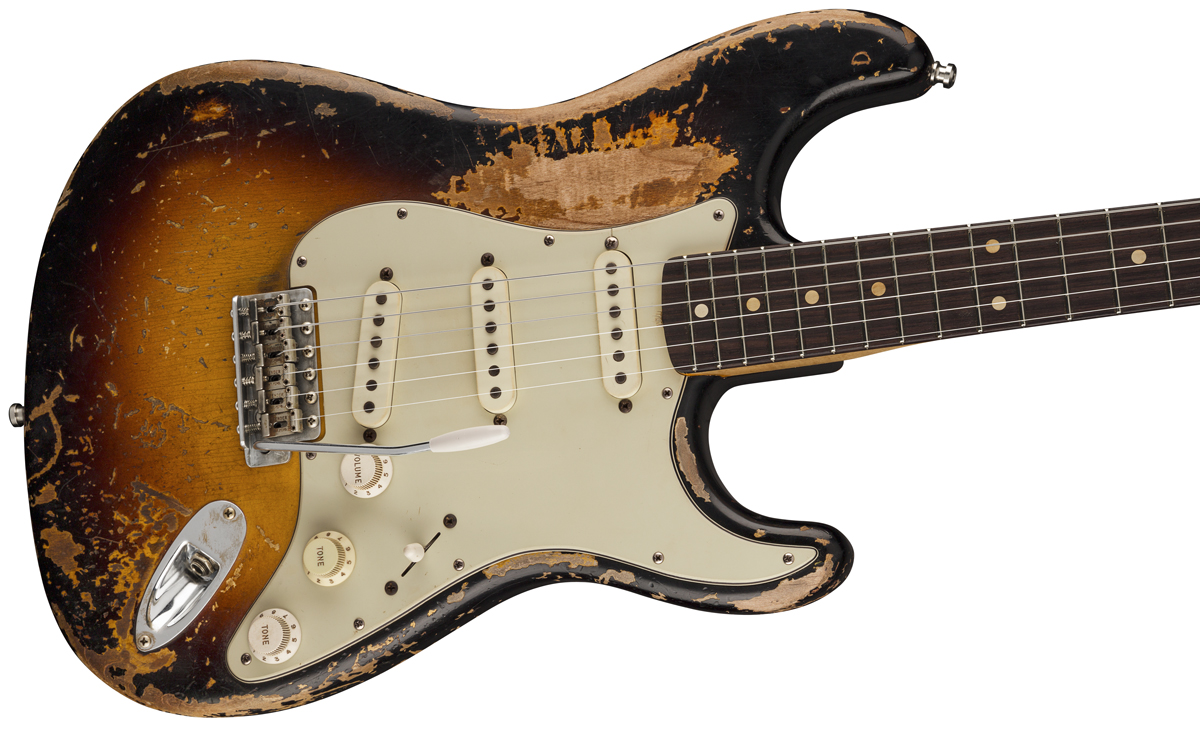How Fender built Mike McCready’s Custom Shop Strat, one of its most intricate replicas yet
The Pearl Jam guitarist and Master Builder Vincent Van Trigt detail how the '59 became a '60, and what went into making the painstaking recreation

Generally speaking, a signature guitar model offers fans an opportunity to learn more about an iconic instrument – from the woods to the electronics to the appointments – used by their favorite player and on some of their favorite songs.
But in the case of Fender’s new Custom Shop replica of Mike McCready’s famed 1959 Stratocaster, it was the artist himself who learned something new – for starters, that the guitar was actually built in 1960. “I was shocked,” McCready says with a laugh. “It was like, ‘Was it all a lie? What happened?’ ”
What happened, as we now know, is that McCready first purchased the beloved Strat in 1991, after Ten began taking off. “It was the first guitar I bought when we started making money,” he recalls. “I was like, ‘Okay, I’m going to buy a vintage guitar, and I’m going to buy a ’59. Because I had read that Stevie [Ray Vaughan] had a ’59, and now I could afford one.”


Sometime later, Pearl Jam’s longtime luthier in Seattle, Mike Lull, discovered after working on the guitar that the Strat was actually a 1960 model and notified the band’s equipment manager, George Webb.
Seeing as McCready was by that point wedded to the fact that his main axe was, indeed, a ’59 (he even has a commemorative “ ’59” tattoo on his wrist), they decided to let the guitarist go on believing as much. “George didn’t want to tell me, because I was so invested in the ’59 thing,” McCready says. “He didn’t want to break my heart.”
But when Fender got its hands on the Strat in February 2020, Custom Shop Master Builder Vincent van Trigt dissected the guitar and confirmed what some already knew: “It said it right there in the back cavity, under the springs: 1960,” van Trigt recalls.
McCready may have been mistaken about his guitar’s birth year, but there’s no denying that his Strat contains some serious mojo. “It’s probably the best-playing guitar I have,” he says. “The neck is kind of worn in, which I love, and the feel is just perfect. There’s nothing like it to me.”
Get The Pick Newsletter
All the latest guitar news, interviews, lessons, reviews, deals and more, direct to your inbox!
As for how it sounds? Just take a listen to much of McCready’s work with Pearl Jam, reaching back to 1993’s Vs (it handles the solo to Daughter, for one) up through the new Gigaton (that’s the Strat on Dance of the Clairvoyants).
Almost every time I play Even Flow, it’s this guitar
Mike McCready
Or witness him onstage, where the vintage axe is a mainstay – “almost every time I play Even Flow, it’s this guitar,” he says.
All of which means that the new Mike McCready 1960 Fender Custom Shop Stratocaster comes complete with plenty of history and mythology, both musical and otherwise. So when it came time to replicate the instrument for the limited run (just 60 in all), both Fender and the Pearl Jam guitarist wanted to be sure they nailed it. And nail it they did.
“The guitar came to Fender and I spent a day just taking it apart – every screw, every wire,” van Trigt says. “One thing that was very important to Mike was getting the neck shape and the feel correct, so I spent a lot of time on that, recording all the measurements. I had to make sure we got it right.”
As for the actual specs on that neck? “It was a 7 ¼-inch radius at one point, and it was turned into a 9 ½-inch radius,” van Trigt says. “So it’s not super thin, but it’s on the thin side. And it has a super-silky feel.” Those characteristics are reflected in the new model’s ultra-comfy flat-sawn 1960 “oval C” profile flame maple neck, which is topped with a flat-lam rosewood fingerboard with 21 vintage frets.
Additionally, the guitar sports an ultimate Relic lacquer finish on a two-piece select alder body, as well as a three-ply vinyl pickguard, vintage-style synchronized tremolo with Callaham bridge block, vintage-style tuning machines, a bone nut and a wing string tree with metal spacer.
As for pickups, the Strat comes loaded with a trio of custom Josefina hand-wound single-coils matched to the originals, and connected to a five-way switch and vintage wiring, including a “treble bleed” tone capacitor.
This was the most involved replica I’ve done. The finish process took a lot of planning because of all the wear
Vincent van Trigt
“They have a super-punchy warm sound, exactly like Mike’s guitar,” van Trigt says. And while McCready says that Fender did a “phenomenal” job in capturing the tone and feel of his original Strat, there’s another aspect of the instrument that required an extremely exacting touch – replicating the body’s heavy wear, some of which predates McCready’s ownership of the guitar.
“Some of that was already there when I bought it,” McCready says. “But a lot of it is from years and years of me playing it.” The complete absence of any finish above the pickguard, for example, “is from me just strumming like crazy. But I love how old guitars get worn and beaten up. It’s part of the soul of the instrument, and a marker of the people who have played it.”
Adds van Trigt, “This was the most involved replica I’ve done. The finish process took a lot of planning because of all the wear.”

Of course, there’s wear… and then there’s wear. In addition to nicks, scratches, dings and checking, McCready’s original Strat – as well as the replica – has a chunk of wood missing from the top and front of the headstock. As for why? Call it a rock ‘n’ roll tax.
“In the mid'-90s, Pearl Jam played as Neil Young’s backup band, which was this totally amazing thing,” McCready says. “So we’re in Europe and we’re at the end of Down by the River or something, and Neil’s doing his thing and I’m like, ‘Aahhh! I’m so into it!’ And I take the Strat and I put it into the speaker cabinet, thinking I’m just gonna hit just the speaker. But I actually hit the side where the wood is, and I chipped off a piece of the headstock.”
McCready laughs. “It was a moment of intense rock passion. So I have that memory, and sometimes I think, ‘Fuck, I wish I didn’t do that.’ But Fender recreated it perfectly.”
So perfectly, in fact, that they managed to fool even McCready himself with the final product. “The greatest thing I can say about the guitar is that after Fender sent me the prototype, I picked it up thinking it was my original,” McCready recalls. He laughs. “I sat there playing for a little bit, and then finally I was like, ‘Wait a minute…’”
- For more info on the Limited Edition Mike McCready 1960 Stratocaster, head to Fender Custom Shop.
Rich is the co-author of the best-selling Nöthin' But a Good Time: The Uncensored History of the '80s Hard Rock Explosion. He is also a recording and performing musician, and a former editor of Guitar World magazine and executive editor of Guitar Aficionado magazine. He has authored several additional books, among them Kurt Cobain: Montage of Heck, the companion to the documentary of the same name.
“It holds its own purely as a playable guitar. It’s really cool for the traveling musician – you can bring it on a flight and it fits beneath the seat”: Why Steve Stevens put his name to a foldable guitar
“Finely tuned instruments with effortless playability and one of the best vibratos there is”: PRS Standard 24 Satin and S2 Standard 24 Satin review










